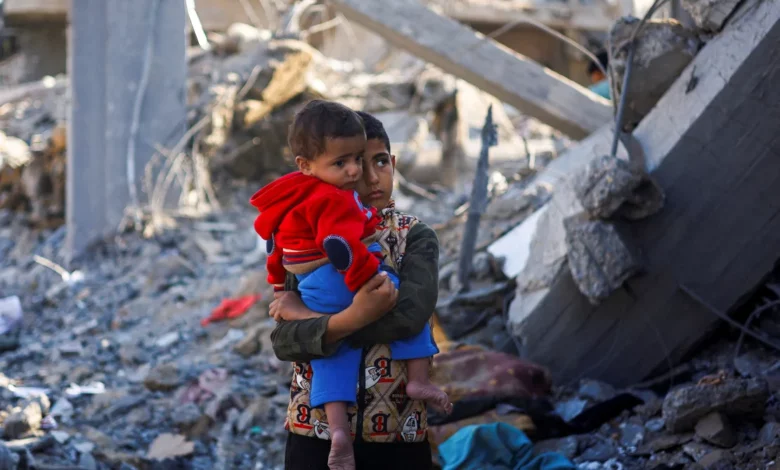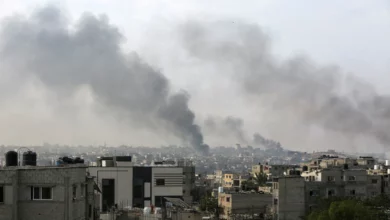
“Every time we think things cannot get any more apocalyptic in Gaza, they do,” said Martin Griffiths, the top UN emergency relief official, in a statement on Monday. “People are being ordered to move again, with little to survive on, forced to make one impossible choice after another,” he said.
“Such blatant disregard for basic humanity must stop,” he also said.
Israel has been intensifying its aerial bombardment of southern Gaza in pursuit of Palestinian militant group Hamas and said over the weekend that it will expand ground operations to the whole of the territory.
“Intense battles” are still taking place in northern Gaza, where two Israeli soldiers were killed during “close-quarter combat” with Hamas fighters, the military said on Monday.
United Nations Secretary General Antonio Guterres on Monday appealed to the IDF to spare civilians from more suffering. “Civilians – including health workers, journalists and UN personnel – and civilian infrastructure must be protected at all times,” Guterres’ statement said, noting that despite evacuation orders, “there is nowhere safe to go in Gaza.”
Palestinian civilians have been told to flee large swaths of Gaza, with the Israel Defense Forces (IDF) releasing QR codes that show several online maps detailing areas it deems unsafe. However it is unclear how many residents the warnings are reaching, given damage to the enclave’s telecommunications services and electricity shortages.
IDF spokesperson Jonathan Conricus told CNN Monday evening that the QR code system it has implemented in recent days to designate unsafe areas of Gaza is not perfect but is “the best thing that we can do.”
As of last week, 1.8 million people in Gaza were estimated to be internally displaced, according to UN – roughly 80% of the population.
Scores of wounded people could be seen being taken from rubble and to hospitals in southern Gaza throughout Monday in footage. One Reuters video showed a baby being rushed from a civilian car into Nasser Hospital in the southern city of Khan Younis. The 2-month-old lies on a stretcher, apparently unconscious, as doctors remove his clothes and connect him to an oxygen supply.
“They told us to leave Gaza, there’s a war in Gaza, so we left (the north) and came here to the south just like they asked. But this is what we’ve found in the south,” Ibrahim Esbeitan, the baby’s father said in the video, pointing at this child.
In Salah Al-Arja, in Rafah, residents were seen trying to rescue their loved ones from the rubble with their bare hands. “We were asleep and safe, they told us it was a safe area, Rafah and all, but at twenty past ten, they stuck it with barrels, destroying all the block, there were children, women, and martyrs,” an unnamed local resident told Reuters.
“There is no safe area, neither Rafah, nor Khan Younis, nor Gaza, nor Dier, they are all liars, they say it is a safe area, they let us seek refuge, they evacuated Khan Younis and Gaza and still they bomb.”
The head of the United Nations Relief and Works Agency for Palestine Refugees, Philippe Lazzarini, also warned against “horrors” that could follow in the wake of Israel’s expanding military operation, noting that an additional 60,000 people are now seeking shelter in overcrowded UN facilities.
“The evacuation order pushes people to concentrate into what is less than one-third of the Gaza Strip. They need everything: food, water, shelter, and mostly safety. Roads to the south are clogged,” Lazzarini said Monday, noting that access to water is limited in Gaza.
To resupply humanitarian aid efforts in Gaza, 180 humanitarian aid trucks carrying food, water, shelter materials and medical supplies were sent to the Rafah crossing on Monday at the request of the US Administration and in coordination with Egypt, according to Israel’s Coordinator of Government Activities in the Territories. Two diesel fuel tankers were also sent from Egypt to aid agencies operating in the strip, it said.
Health system struggling
What remains of the health system and infrastructure in Gaza is far from sufficient for the battered population’s needs as it enters a third month of siege, experts say.
Eighteen of Gaza’s 36 hospitals are still functioning, but can only provide partial services, the World Health Organization (WHO) said on Monday, adding that the 12 operational hospitals in the south are “the backbone of the health system.”
A WHO team visiting Nasser Hospital said the conditions there were “catastrophic” amid a flood of patients on Monday. “The the building and hospital grounds [are] grossly overcrowded with patients and displaced people seeking shelter,” the statement said. “The emergency ward is overflowing with patients…Many patients are being treated on the floor.”
In a voice message posted on Monday, UNICEF spokesperson James Elder also described harrowing conditions in Nasser Hospital rooms after a blast had hit less than 100 meters away.
“There must be a hundred people, children now have been woken up by the bombs and explosions,” Elder said as babies’ cries could be heard in the background.
“Parents just have that look of.. the feeling no parent ever wants to experience, which is helplessness,” he said.
On Monday night, the Israeli military was heavily bombarding the vicinity of Kamal Adwan Hospital in northern Gaza, causing damage, a journalist at the hospital told CNN in a voice message, describing the situation as “very serious.” He added that he could hear airstrikes and artillery fire, and that anyone moving near the hospital was being shot at.
“There is damage inside the [Kamal Adwan] hospital due to the heavy fall of shrapnel on the hospital building and on the displaced people in the hospital’s yard,” Anas Al-Sharif said as explosions were heard in the background.
The Hamas-controlled Ministry of Health in Gaza also accused the Israeli military of targeting Kamal Adwan hospital in a statement late Monday. However, CNN cannot independently verify those claims, and the Israeli military did not respond to request for comment. The IDF has maintained that it is targeting Hamas infrastructure across Gaza.
Reporting contributed by CNN’s Tamar Michaelis, Lauren Kent, Lina El Wardani, Abeer Salman and Kareem Khadder.




